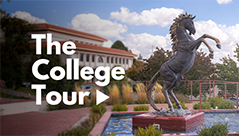The students in Assistant Professor Erin Wheary’s Appreciation of Sculpture class could recently be found on a sunny Tuesday morning on the Graham Gym patio, arranging their latest creations for a photography opportunity. “Let’s try the Ball jar toward the center,” called the photographer, Jay Hemphill, as the students moved their sculptures, “The Apple watch can go on the bottom step.”
The students were arranging oversized sculptures of everyday objects, all painted the same purple hue and ranging in size from large to massive. The sculptures, made of chicken wire and cardboard and covered with a skin of papier-mâché, were the result of an assignment given by Wheary early in the semester.
“I like to ground my teaching in contemporary art,” Wheary explained, “And so this piece is inspired by the work of [Swedish-born American sculptor] Claes Oldenberg. [Students in the class] just went over elements of art and principles of design, and the idea is to transform the scale of an everyday object.”
Oldenberg is known for his public installations of large-scale recreations of everyday objects. While his sculptures are usually painted to more closely resemble the object they are modeled on, Wheary asked students to all use the same paint. “By painting them all the one solid color,” she said, “then we really get into conversations about texture and about the scale, rather than about the object. [The conversation] becomes one about an art object, not just about a replica.”
“This is the first time I shifted [the assignment] to one solid color,” explained Wheary, “and it was very interesting to watch the students because first they built the structure [and] then when we got to the painting, all this visual noise that had been happening all disappeared. Then [students] really got interested in editing and applying textures and adding the little elements that really make the object, so you can tell what it is.”
The idea behind the assignment, she said, is to “introduce students to different ways of thinking and making, also . . . to understand the history of art through doing.”
Art major Natalee Drissell, a student in the class, said that the project gave her a new way of observation. Oldenberg “makes large-scale recreations of everyday objects in a way that, when you interact with them, it completely changes the way you think about the object, and you think about form,” she said, “I have personally interacted with some of his stuff. He did this giant spoon with a cherry on it. It’s called the Spoonbridge [and Cherry] in Minneapolis, Minnesota. I saw it when I was really little. It is a really interesting interaction of space and form, and it affects how you think about the everyday when you see something commercial on a large scale.”
For her own sculpture, Drissell decided to create a skeleton key. “I think [the actual key] is about an inch and a half, so I scaled it up a lot. This,” she said referencing her sculpture, “is seven feet long.”
“I wanted to interact with form in a different way,” Drissell explained, “A skeleton key is not super functional. Obviously, you can unlock a door with it, but a lot of the shape is just aesthetic, so when you blow it up, you really start paying attention [to those aesthetics].”
The key that Drissell selected as a model for the project also has personal significance for her, as it is the key to her old house. “I used to live in this century-old farmhouse, and this was the key to front door.”
“This is my first time working with sculpture, and I am really surprised by how much I am drawn to the medium,” Drissell reflected, “Erin does a really good job of letting us get our feet wet with a lot of different materials.” She added that the course has encouraged her “to try a lot of different things and to dream big. [Wheary] helps us achieve that, so it was really cool to realize that I could do something that was so large scale and so accurate within the first three weeks of class.”
Wheary, who is in her first semester at WNMU, said that she was excited to join the Expressive Arts Department and to share her own approach to sculpture with WNMU students. “[Retiring Professor of Sculpture] Michael [Metcalf] made such a rich history for this program, and I respect what he did in such a huge way,” she said, adding, “I am really excited to bring my own spin to things.”


